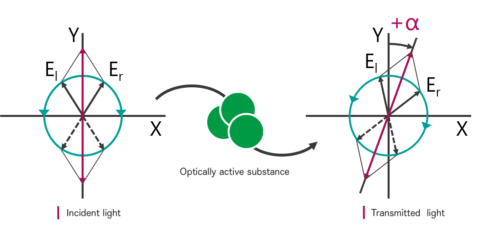
Optically active substances are molecules that have mirror images with L- and D-forms. Examples of such molecules are thalidomide and glyceraldehyde. Such substances cause a rotation of the polarization plane of linearly polarized light, referred to as optical rotation (OR). The wavelength dependence of OR is called optical rotational dispersion (ORD). As shown in Figure 1, when light that is linearly polarized along the Y-axis has its polarization plane rotated to the left, this is referred to as levo (l) or (-) optical rotation. When the rotation is to the right, it is referred to as dextro (d) or (+) optical rotation. The rotation angle is given by α, which can be positive or negative.
Optical rotation (OR) measurements determine the polarization rotation angle as a function of wavelength, and are the easiest method for measuring concentration and optical purity (ratio of L-form and D-form). The Japanese Pharmacopoeia, the US Pharmacopoeia, and the European Pharmacopoeia define test items for pharmaceutical products, and measurement conditions such as the wavelength, temperature, and concentration are standardized internationally.
By standardizing the analysis procedure (SOP), including factors such as the sample preparation method and the measurement conditions, comparisons of analysis results can be made worldwide. The specific rotation formula is given by:

For the polarimetry, a sodium (Na) lamp, mercury (Hg) lamp, halogen (WI) lamp, and LEDs can be used as light sources.
A sodium (Na) lamp produces strong sharp emission lines (so-called D-lines) at 589.6 and 589.0 nm, and no emission at other wavelengths. In recent years, other light sources have been used, and even the 17 Japanese Pharmacopoeia stations permit the use of light sources other than Na. There is an annotation that states “If a light beam with a wavelength close to that for a Na D-line can be obtained using an appropriate interference filter, a continuous light source such as a xenon lamp can be used as an alternative.” In other words, to use other light sources, they should provide results equivalent to those for a Na lamp, which is accepted as the standard.
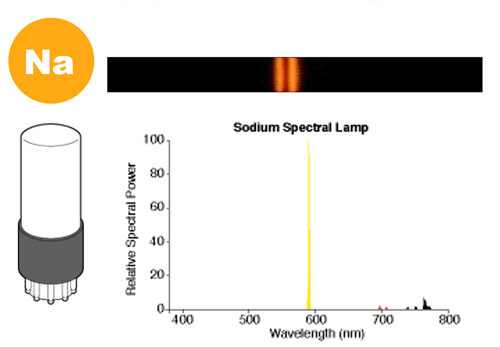
Mercury (Hg) lamps have been used as light sources for polarimetry because they produce many emission lines from the ultraviolet to the visible region.
It is possible to perform measurements at 253, 280, 296, 302, 313, 334, 365, 405, 436, 546, 578 nm in combination with appropriate optical filters.
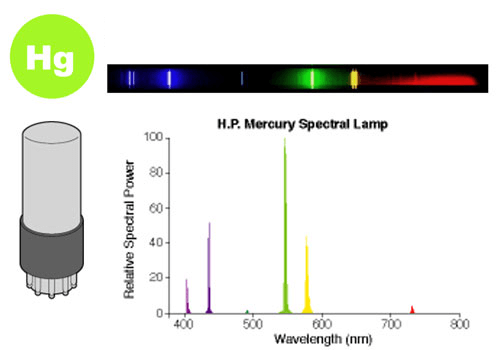
A halogen (WI) lamp emits over a continuous range of wavelengths, and it is possible to select the desired wavelength using a filter. However, measurement errors due to the transmission characteristics of the filter, that is, the difference between the center wavelength of the filter and the wavelength obtained by the bright line, cannot be avoided. Figure 2 shows a measurement of optical rotation for pirarubicin done with a Na lamp and a WI lamp. The same measurement at 589 nm shows different values for the specific rotation using the two light sources. The result for the WI lamp is due to the large change in the specific rotation within the transmission wavelength range of the filter.
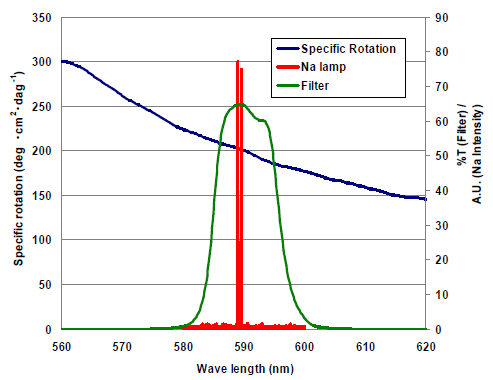
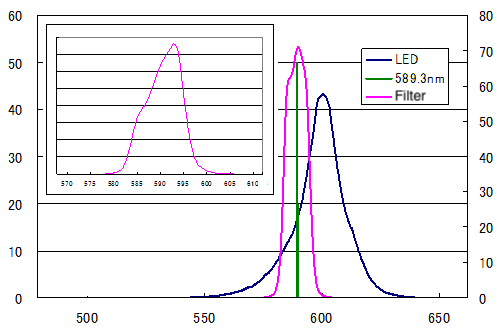
LED light sources have a wider emission wavelength range than a bright emission line or a laser. However, they have a long service life, generate little heat, and stabilize immediately when turned on. The improved performance of interference filters has made it possible to measure at selective wavelengths. However, as shown in Figure 3, the peak position for an LED and the selected wavelength of a filter do not match. The insert shows that the half-width of the extracted light is wide and the shape is irregular. This causes an error in optical rotation measurements.
©Jasco Europe S.R.L. (Socio Unico) Direzione e coordinamento ex. art. 2497 bis c.c. – P.I. 08609570158 | Privacy Policy | Cookie Policy | Manage consent | Realizzazione sito web: Alkimedia
| Cookie | Duration | Description |
|---|---|---|
| cookielawinfo-checbox-analytics | 11 months | This cookie is set by GDPR Cookie Consent plugin. The cookie is used to store the user consent for the cookies in the category "Analytics". |
| cookielawinfo-checkbox-necessary | 11 months | This cookie is set by GDPR Cookie Consent plugin. The cookies is used to store the user consent for the cookies in the category "Necessary". |
| CookieLawInfoConsent | 1 year | Records the default button state of the corresponding category & the status of CCPA. It works only in coordination with the primary cookie. |
| elementor | never | This cookie is used by the website's WordPress theme. It allows the website owner to implement or change the website's content in real-time. |
| viewed_cookie_policy | 11 months | The cookie is set by the GDPR Cookie Consent plugin and is used to store whether or not user has consented to the use of cookies. It does not store any personal data. |
| Cookie | Duration | Description |
|---|---|---|
| Google Maps | Google Maps is a map visualization service managed by Google Inc. and is used to integrate such contents within its pages. |